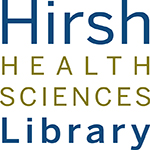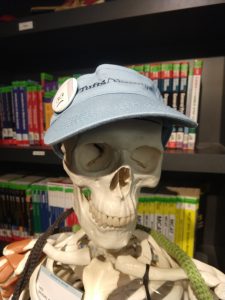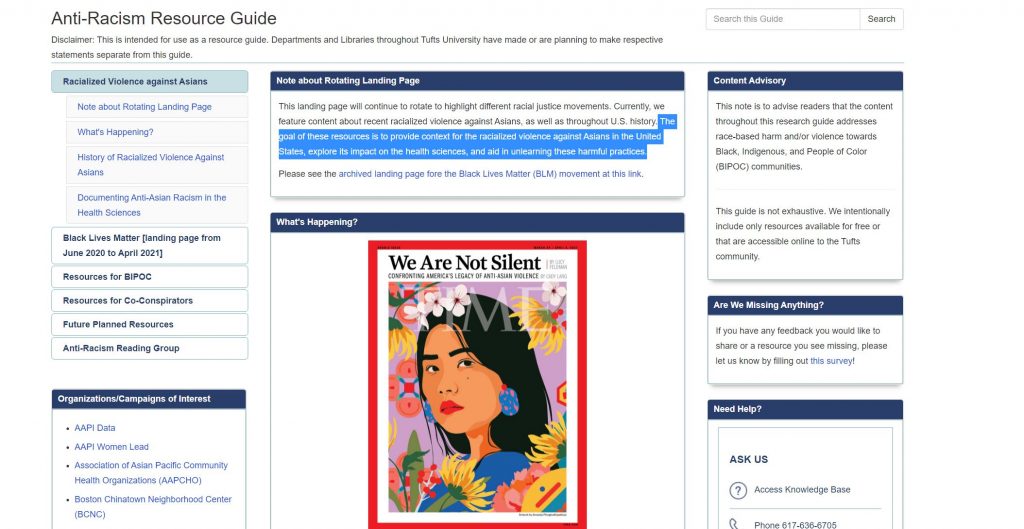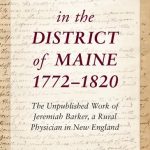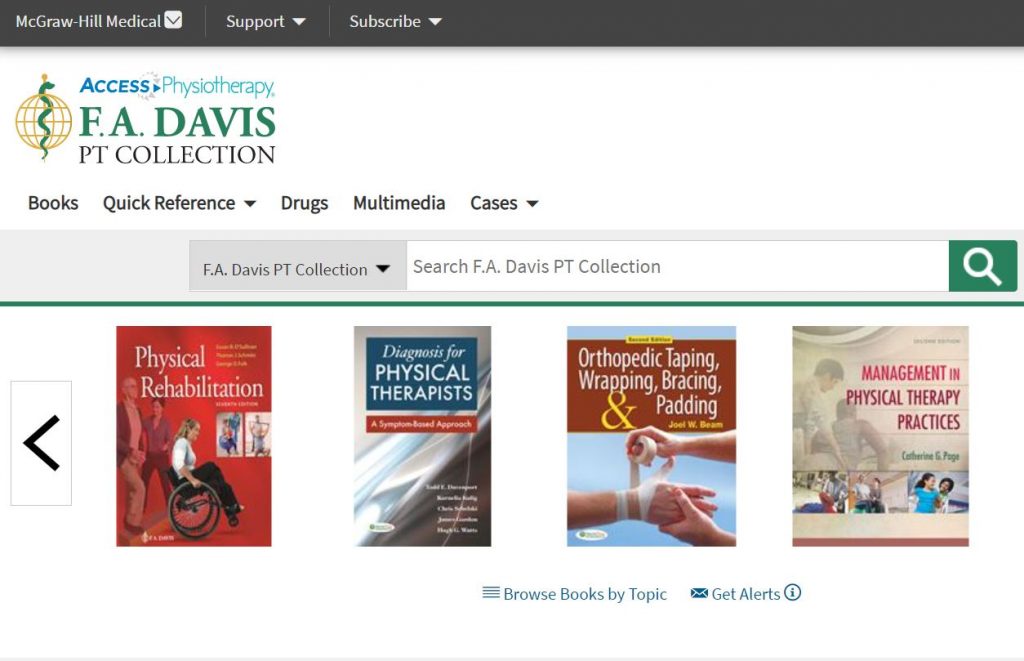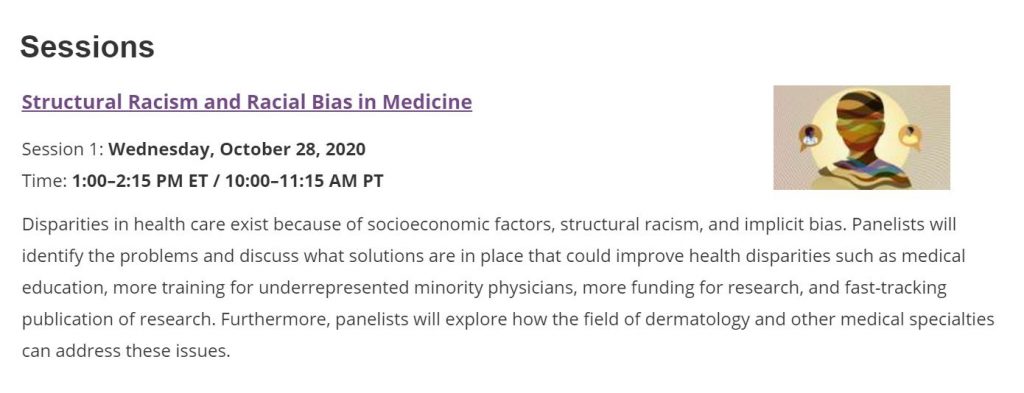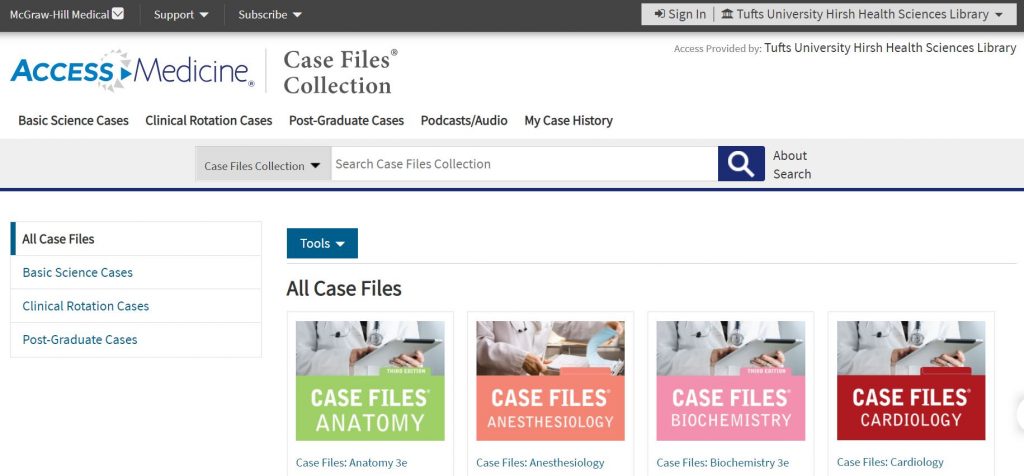Reopening Refresher: Borrowing Materials
We are back in the library! As we transition back into the library, we plan to refresh your memory about the physical library space. Today, as we open the Library Service Desk again, you can now check out study materials for short-term lending.
Since we haven’t been open in over a […]
We are back in the library! As we transition back into the library, we plan to refresh your memory about the physical library space. Today, as we open the Library Service Desk again, you can now check out study materials for short-term lending.
Since we haven’t been open in over a year, all our borrowing policies are on our website. We are at the Library Service Desk on the 4th floor, where you can check out:
- Course reserves and textbooks
- Anatomical models
- Electronics (e.g. laptops, chargers)
Before lockdown, if an item wasn’t returned or renewed on time, this would result in a block. Once we return to the library, everyone will have to sign our Equipment Agreement to checkout anatomical models and electronics. This Agreement outlines our blocking policy, but we’re happy to answer any questions about the policy.
Leisure reading, Graphic Medicine, the Book Stacks etc. (4th, 5th floors) will still be available for long term checkout. Print journals and current periodicals are not available for checkout, but you can browse them on the 4th and 7th floors.
And of course, you can contact us with your questions at hhsl@tufts.edu, call us at (617) 636 6705 or come up to the desk between 7:45 AM and 5:00 PM
We’re happy to see you all in person again (wearing a mask, of course)!
You now have complete access to the NEW Diversity & Culture in Healthcare eBook Collection from OVID! HHSL’s acquisition of this eBook collection was funded by the Hirsh family.
Issues of diversity, equity, and inclusion in healthcare are of utmost importance —This valuable collection contains the below titles in support […]
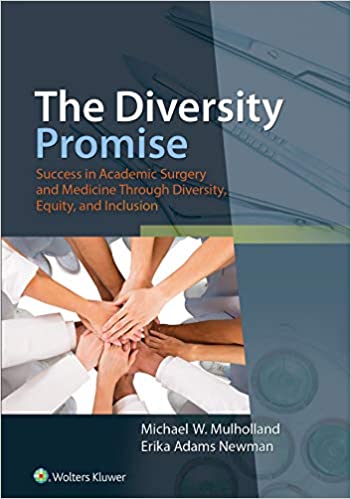
You now have complete access to the NEW Diversity & Culture in Healthcare eBook Collection from OVID! HHSL’s acquisition of this eBook collection was funded by the Hirsh family.
Issues of diversity, equity, and inclusion in healthcare are of utmost importance —This valuable collection contains the below titles in support of this key area of medical education and practice, to allow for well-informed, culturally sensitive healthcare:
- The Diversity Promise: Success in Academic Surgery and Medicine Through Diversity, Equity, and Inclusion
- Migration, Ethnicity, Race, and Health in Multicultural Societies
- Forensic Social Work: Psychosocial and Legal Issues Across Diverse Populations and Settings
- Health Care Politics, Policy, and Services: A Social Justice Analysis
- Public Health Ethics and the Social Determinants of Health
- LGBTQ Cultures: What Health Care Professionals Need to Know About Sexual and Gender Diversity
- Let’s Talk Vaccines: A Clinician’s Guide to Addressing Vaccine Hesitancy and Saving Lives
- Public Health Nutrition: Rural, Urban, and Global Community-Based Practice
[Content Warning: race-based violence against BIPOC, particularly Asian communities]
May marks the start of Asian Pacific American (APA) Heritage Month in the United States. While celebrating milestones and accomplishments of Asian communities is important, so is reflecting on the racialized violence that Asian communities have experienced in […]
[Content Warning: race-based violence against BIPOC, particularly Asian communities]
May marks the start of Asian Pacific American (APA) Heritage Month in the United States. While celebrating milestones and accomplishments of Asian communities is important, so is reflecting on the racialized violence that Asian communities have experienced in the past year and beyond. In order to aid in learning about how racialized violence against Asians has existed in the fabric of the United States, as well as how that impacts health disparities in Asian communities, we have created a new landing page in our Anti-Racism Resources Guide. This rotating landing page focusing on Asian communities also hopes to help highlight parallels between the sufferings of other marginalized communities in the United States in order to recognize the fact that all those who are minoritized are being harmed under the same systems of oppression of white supremacy.
On Tuesday, March 16, 2021, 8 people were murdered in Atlanta, GA at two separate Asian spa locations. 6 of the 8 who were killed identified as Asian and all but one were women. While not all who were killed identified as Asian, many have voiced that these murders happened because a white man targeted Asian women specifically to eliminate his sexual temptations. (More reporting can be found online at the New York Times through this link).
These murders, however, are not the only violent acts that have been perpetrated in Asian communities. As the organization Stop AAPI Hate reports, out of the reported incidents alone, there have been 3,292 incidents in 2020 and 503 incidents that have occurred thus far in 2021 (for the National Report from Stop AAPI Hate and more, visit their website). This violence towards Asians have ranged from spitting, verbal abuse, death, and more. From the stabbing of a 36-year-old man in New York City’s Chinatown, to elder Xie Xiaozhen being punched in the face by a white man in San Francisco, to the murder of elder Vichar Ratanapakdee also in San Francisco, to children as young as 2 and 6 years old being stabbed at a Sam’s Club in Texas, many reports have gone viral. Furthermore, while these attacks have mostly occurred in East Asian and Southeast Asian communities, for decades, the Middle Eastern and South Asian communities have been targeted due to the 9/11 tragedy. Most recently, the Sikh community was attacked in Indianapolis where 4 of 8 victims identified as Sikh. Many more Asians have suffered attacks without their stories being reported or cared about in mainstream media, at their schools, and at their workplaces.
These incidents of hate and violence are not happening in a vacuum. The goal of the resources shared on our new landing page is to provide context for the racialized violence against Asians in the United States, explore its impact on the health sciences, and aid in unlearning these harmful practices.
As always, if you have suggestions on additions to the resource guide, please feel free to fill out the survey linked here.
Post contributed by Andrea Kang, Amanda Nevius, and Christina Heinrich
So it’s March 2021, we still need to stay socially distanced, but you want to celebrate St. Patrick’s Day in someway, perhaps albeit quietly at home. Well I’ve got some great news for you: if you’re a fan of movie nights, we’ve got you covered with Kanopy!
So it’s March 2021, we still need to stay socially distanced, but you want to celebrate St. Patrick’s Day in someway, perhaps albeit quietly at home. Well I’ve got some great news for you: if you’re a fan of movie nights, we’ve got you covered with Kanopy!
Much like with Halloween, I’m here to point you toward some great cinema that’s right at your fingertips, and all included with your being here at Tufts! A quick refresher:
Kanopy is a streaming service that specifically works with libraries. It’s a great source for documentaries, but also for independent cinema, world cinema, classics (like, say, the Criterion Collection), and assorted collections you might not expect to see. I’ve reached the point where I always check Kanopy first for a movie I want to see, just in case. Since Kanopy is a subscription service for libraries, it means all library users will get to see their films – in this case, that means you!
I’ll cut to the chase: there’s an entire category of Irish Cinema on Kanopy. The films run the gamut here, too – there are short films like The Crush (about a middle schooler with a crush on his teacher), the touching Time Traveller (about a child building a homemade DeLorean time machine as an escape from his day-to-day), Second to None (an old man trying to jealousy get revenge on his very slightly older twin brother – this one’s stop animation!), or Kubrick by Candlelight (a pair of people fall for each other during the filming of Stanley Kubrick’s Barry Lyndon).
There are, of course, full length feature films here as well. If you want to give an animated film a shot, I cannot speak highly enough of The Secret of Kells. It’s a movie where the animation looks like an illuminated manuscript come to life, and is absolutely entrancing. If you’d rather something with live actors, you could give Handsome Devil a shot, about a pair of boys stuck in a boarding school room together (incidentally, a winner of a handful of awards, and also a movie that turns up under Kanopy’s LGBTQ Cinema tag as well). On a similar vein is Bortsal Boy, which was nominated for a pair of awards including Outstanding Film with the GLAAD Media Awards.
Or perhaps you’d prefer horror, since I mentioned Halloween up there? Well there are movies like A Hole in the Ground (released by A24, a studio that has a lot of films on Kanopy), or perhaps The Canal (which won an award for being scary!).
That said, if you prefer comedy, you could certainly do worse than Gold, starring Maisie Williams (Arya from Game of Thrones).
Finally, I would be remiss if I didn’t address those documentaries I mentioned above. One is Brand Irish, a film that approaches the question of how “Irish” became such a phenomena (example: the ubiquitous of St. Patrick’s Day, or the Irish pub). If you prefer something longer, The Great Courses series has three separate looks at Ireland, its people, and its heritage. The Celtic World focuses on the ancient Celts – who we thought they were and who we think they are now; Roots of the Irish Identity, taking a look at Ireland from the Celts up through the Middle Ages in order to give context to today; and The Irish Identity, focusing on the 20th Century and particularly the Irish Renaissance. Those last three are entire series, so maybe brew some tea up and settle in.
No matter how you choose to spend your week this week, we at Hirsh hope you’re staying safe and healthy, and are having as great a time as you can right now. Here’s to the weather warming up and staying there soon!
Sláinte,
Tom
Diseases in the District of Maine 1772 to 1820
A recent and notable addition to our collection is this book of medical history, written and gifted to the library by Dr. Richard J. Kahn, graduate of Tufts Medical School, m1966. Dr. Kahn has also been professor to Tufts students for most of 50 years, now through the Tufts/Maine Medical program. […]
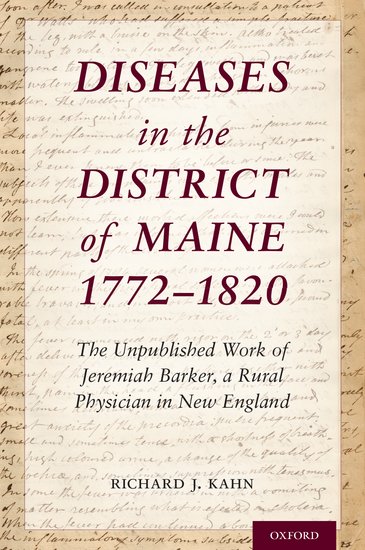
https://global.oup.com/academic/product/diseases-in-the-district-of-maine-1772—1820-9780190053253?cc=us&lang=en&
A recent and notable addition to our collection is this book of medical history, written and gifted to the library by Dr. Richard J. Kahn, graduate of Tufts Medical School, m1966. Dr. Kahn has also been professor to Tufts students for most of 50 years, now through the Tufts/Maine Medical program. Below he provides a summary of the book and its contents:
“This is the story of a lost manuscript, an unpublished book written 200 years ago by a rural New England physician, who lived and practiced in Gorham and Portland, ME. It will be an important new primary source for medical history, research, and teaching for scholars and will also be of interest to general readers for, as Barker wrote on title page, it was ‘Written so as to be intelligible to those who are destitute of Medical Science.’ My introductory chapters have kept Barker’s goal, to be accessible to the general reader, in mind.
The Jeremiah Barker Papers consist of two manuscript boxes containing letters, casebooks, and several texts with marginalia by Barker, in addition to his unpublished manuscript. It is a fifty-year record of his reflections on diseases, epidemics, diagnoses, treatments, and outcomes, with an unusual effort to consult and cite the medical literature and other physicians in a changing medical landscape, as practice and authority shifted from historical to scientific methods. In short, it is a remarkable record of medicine as practiced in northern New England over 200 years ago, during the shift of medical authority from Hippocrates and Galen to the beginnings of the scientific method.
The publication of Barker’s manuscript, fully annotated, includes my five-chapter introduction, that is a sketch of Barker’s background, education, and writings, the difficulty in obtaining the medical literature through books, journals, newspapers, and the post, and a chapter contextualizing the changing medical climate as science supplanted the words of Hippocrates and Galen. One chapter examines Barker as a ‘dangerous innovator’ experimenting with the new chemistry of Lavoisier. The final chapter suggests ways for the general reader to approach a 200-year-old manuscript, avoiding ‘presentism,’ the post hoc fallacy, and confirmation bias. A glossary will define and explain terms and medications not commonly used in the 21st century.”
You can find Diseases in the District of Maine 1772 to 1820 on the 4th floor of the library at the New Books display.
AccessPhysiotherapy & The F.A. Davis PT Collection
You now have full access to the following two physiotherapy collections from McGraw-Hill Medical: the AccessPhysiotherapy and F.A. Davis PT Collection. These collections include clinical textbooks, cases, and review preps:
“AccessPhysiotherapy (APT) is an online medical resource that provides students with the tools they need to excel […]
You now have full access to the following two physiotherapy collections from McGraw-Hill Medical: the AccessPhysiotherapy and F.A. Davis PT Collection. These collections include clinical textbooks, cases, and review preps:
“AccessPhysiotherapy (APT) is an online medical resource that provides students with the tools they need to excel in basic and advanced studies and crucial test prep. APT provides students and residents with interactive content, self-assessment, and leading medical texts to enhance decision-making at the point-of-care. It allows for practicing physical therapists to brush up on their medical knowledge to ensure best patient outcomes.”
“The F.A. Davis PT Collection on AccessPhysiotherapy is the most comprehensive digital subscription product on the market for educators and physical therapy students. This partnership between F.A. Davis and McGraw-Hill Education brings you a comprehensive online PT resource that covers the entire spectrum of physical therapy–for viewing on any device.”
Self-Checkout is Now Available!
Need to check out a physical book? We have an app for that! Download meeScan (available on Google Play or iTunes) to check out books when you’re at Hirsh Library. All you need to do once you download the app is log in […]
Need to check out a physical book? We have an app for that! Download meeScan (available on Google Play or iTunes) to check out books when you’re at Hirsh Library. All you need to do once you download the app is log in with your Tufts username and password (please note: you must be physically in the library in order to log in). After finding a book in our collection, tap the plus sign (+) and scan the Tufts Library book barcode to check out the book. If you are affiliated with Tufts Medical Center (TMC), the barcode on the back of your TMC ID will also work to log into the app. If you do not have a barcode, please contact us and we will be able to set you up with an account and barcode.
NEJM: Racism and Racial Bias in Medicine
The New England Journal of Medicine (NEJM) has recently created a topic page which highlights select articles dealing with race and medicine. The articles have been pulled together with the hope of improving research, public health, patient care and professional training:
“The Race and […]
The New England Journal of Medicine (NEJM) has recently created a topic page which highlights select articles dealing with race and medicine. The articles have been pulled together with the hope of improving research, public health, patient care and professional training:
“The Race and Medicine collection reflects NEJM’s commitment to understanding and combating racism as a public health and human rights crisis. Our commitment to antiracism includes efforts to educate the medical community about systemic racism, to support Black and other minority physicians and aspiring physicians, and ultimately to improve the care and lives of Black and other minority patients” (NEJM, 2020, para. 1).
Additionally, the NEJM is cosponsoring four webinars in the virtual series, The Impact of Skin Color and Ethnicity on Clinical Diagnosis and Research, which will run from October 28–December 2. The topic of the first webinar is Structural Racism and Racial Bias in Medicine, and will take place on Wednesday, October 28 from 1:00-2:15 PM ET. Registration is available here.
Boo!
Okay, now that I have your attention: welcome to October, the month of horror movies! “But Tom,” you say, “what can I watch that won’t break the bank?” Well, I have some good news for you, and it will come free with your being part of Tufts: Kanopy!
Kanopy is a streaming service that Tufts subscribes to, and you therefore have access to at no extra cost. There are a ton of interesting documentaries, indie films, and movies from around the world on there, but right now I am here to talk about some good old fashioned horror films that you can watch for free (which I will keep reminding you of). And you can watch it on your laptop, phone, or even cast it to your TV, so it’s nice and convenient too
Note: every single link below will lead you to a listing on Kanopy unless otherwise noted. But a link is not an automatic endorsement – this is just a cross-section of somewhat famous movies, some of which you may have heard of, others you may not have. If I think highly of a particular film, I will note it in the description.
Older School Horror
Let’s say you’re like me, and one of the things you’re always curious about is where horror movies really started taking hold. What would you guess? Hitchcock, perhaps, with Psycho? Well, that’s 1960, and he did Dial M for Murder in 1954. So maybe even earlier? What if I told you that The Cabinet of Dr. Caligari is a crazy psychological horror film from 1919? Or that Nosferatu is an unsettling vampire movie from 1922? Nosferatu, by the way, was a super unauthorized adaptation of Bram Stoker’s book Dracula, and the vampire design stands strong in the pantheon of frankly terrifying looking monsters.
But hey, maybe silent films aren’t your thing. That’s cool! Not everyone is into them. What about something like Black Sabbath from 1963 (no, not the band, although they’re excellent too). It’s a horror anthology starring Boris Karloff! Or 1964’s The Last Man on Earth starring Vincent Price, based on the book I Am Legend? Or, heck, speaking of Vincent Price, why not give House on Haunted Hill a shot?
I would be remiss if I didn’t end this section with Black Christmas. It’s not the first slasher film (arguably, that could be Psycho), but it laid the groundwork for the behemoths that would come after, like Halloween, Friday the 13th, Nightmare on Elm Street, and Scream. So worth a watch if you’re into slashers!
Zombies and Creepy Towns Oh My
Let’s just get this out there: George Romero is King of the Modern Zombie. Every single zombie movie or TV show you have seen owes itself to Romero’s legacy, and particularly his startling debut Night of the Living Dead. In 97 minutes, in stark black and white, all filmed on the outskirts of Pittsburgh in a single house, Night of the Living Dead is, somehow, more than you’re ready for, even if you’ve watched all 157 seasons of The Walking Dead. And hey, if you’re on a Romero kick, why not check out Day of the Dead while you’re there? It’s the 3rd of his original Dead trilogy, and the opening song got sampled by The Gorillaz for their track “M1A1” off their debut album. Talk about legacy.
If you’d prefer “creepy town with murderers,” there’s always The Hills Have Eyes, from legend Wes Craven (who younger members of the audience may recognize from Scream fame). Incidentally, if you like that, The Hills Have Eyes Part 2 is also on Kanopy.
Time to Laugh
Okay, that last section got heavy. Let’s get goofy. Tucker & Dale vs Evil is a send up of the slasher genre, particularly the “cabin the woods” type (like Friday the 13th). It’s a combination of “weekend fishing trip gone wrong” and “slasher flick,” and is a lot of fun for it. There is also the amazing What We Do in the Shadows, directed by Taika Waititi. This answers the question “what if vampires of different styles all lived in a house together as roommates in the modern era?” and answered it so well that there’s now a follow-up show with 2 seasons under its belt. I think I’ve watched each of these two movies twice now, and plan to watch them more. Indicidentally, Taika has two other movies on there: Boy and the heartwarming Hunt for the Wilderpeople. (If his name sounds familiar but you can’t place it: recently, he directed Thor: Ragnarock, and Jojo Rabbit. These are all from before that).
Although this one isn’t strictly a comedy, The Blob is a 1959 movie starring a teenage Steve McQueen, about a gelatinous blob that somehow terrorizes a town. Which feels like it’s got a great comedic vibe to it by today’s standards, you know?
Let’s Get Weird
Okay. Maybe the other stuff isn’t really your vibe. What if it’s the kind of horror movie filled with tension and weirdness? Like 1977’s Suspiria, directed by Italian master of horror Dario Argento? It was recently re-imagined (which might be where you recognize the name from), but this movie about a ballerina getting caught up in a dance company run by an evil witch still hits strong. Or perhaps Enemy, where Jake Gyllenhall plays both a minor movie actor and the stranger who looks identical to him, and ends up stalking him? Maybe Scanners, which is David Cronenberg’s movie about people who can explode heads. Or you could always check out David Lynch’s Eraserhead, which is pure David Lynch weirdness.
Of course, for some very modern and recent weirdness, you could always watch 2019’s The Lighthouse, starring Willem Dafoe, Robert Pattinson, crazy facial hair, and crazier accents. And yes, that Robert Pattinson.
A24
Fun fact: the director of The Lighthouse also directed 2016’s The Witch, both of which were produced by A24, a studio with a strong showing on Kanopy. But I give them their own section because of some other movies of theirs you may recognize: Hereditary and Midsommar are both from the studio, as is Green Room. Go give their entire catalog a look, but here’s a link to their horror offerings.
At the end of the day, you’re the only person who knows what you’ll want to watch. But please know, I’m not even scratching the surface of Kanopy‘s offerings – they have 414 films listed under Horror & Thriller, which means if you started today and watched 1 per day you’d finish on November 30, 2021. And that’s assuming they don’t add more (which, come on, of course they will).
So. You have access to a treasure trove of free movies, and this is the season for horror. Go to the JumboSearch listing for Kanopy, follow the link out to the site, sign in using your Tufts username & password, and really make this month work for you! Five minutes worth of work for a ton of entertainment, and not a single extra dime spent. Aside from the popcorn you’ll need, but you’re on your own for that.
Spookily yours,
Tom
Access Medicine: Case Files Collection
The Case Files Collection from Access Medicine has recently had a number of updates, which makes this a good time to review this useful resource. With cases from Basic Science, Clinical Rotation, and Post-Graduate, the collection now includes Case Files Podcasts found in the global navigation bar […]
The Case Files Collection from Access Medicine has recently had a number of updates, which makes this a good time to review this useful resource. With cases from Basic Science, Clinical Rotation, and Post-Graduate, the collection now includes Case Files Podcasts found in the global navigation bar under “Podcasts/Audio.” They are produced by the primary author of the series, Dr. Eugene C. Toy, MD and highlight key concepts from the cases found in the collection in short downloadable episodes.
Below is an overview of the Case Files series if you are not familiar with the collection: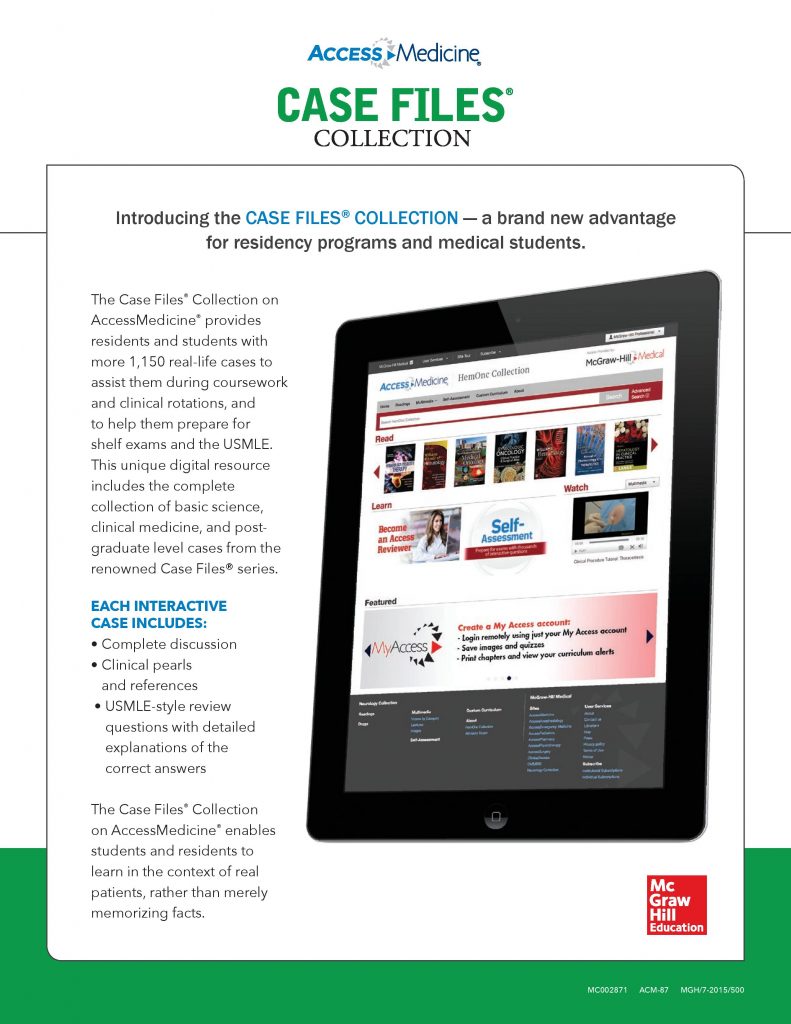
Here are the direct links to our catalog for each subject in the collection:
- Case Files: Anatomy
- Case Files: Anesthesiology
- Case Files: Biochemistry
- Case Files: Cardiology
- Case Files: Critical Care
- Case Files: Emergency Medicine
- Case Files: Family Medicine
- Case Files: Geriatrics
- Case Files: Gynecologic Surgery
- Case Files: High-Risk Obstetrics
- Case Files: Internal Medicine
- Case Files: Medical Ethics and Professionalism
- Case Files: Microbiology
- Case Files: Neurology
- Case Files: Neuroscience
- Case Files: Obstetrics and Gynecology
- Case Files: Orthopaedic Surgery
- Case Files: Pathology
- Case Files: Pediatrics
- Case Files: Pharmacology
- Case Files: Physiology
- Case Files: Psychiatry
- Case Files: Surgery
Recent Posts
Categories
- 4th Floor Tabling (3)
- affiliation (4)
- Announcements (353)
- Book/Resource Reviews (117)
- Hours (131)
- Interviews (4)
- New Titles & Resources (114)
- News & Events (266)
- Open Workshops (48)
- Outside News & Events (66)
- resources (18)
- throwback thursday (5)
- Tips & Tricks (135)
- Uncategorized (148)
Tags
4th floor affiliation books Boston circulation crafts electronic resource electronic resources events exams extended hours food fun fun lab funlab graduation HHSL Hirsh Health Sciences Library holiday holiday hours holidays hours leisure reading library fun lab library service desk library staff new books open access open access week open workshop Open Workshops reserves resources staff statistics summer survey tea Thanksgiving therapy dogs Tufts Hirsh Health Sciences Library website welcome! writing consultants writing helpFollow us @TuftsHHSL!
Twitter feed is not available at the moment.
